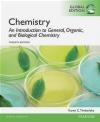Chemistry: An Introduction to General, Organic, and Biological Chemistry, Global Edition
Karen Timberlake
Chemistry: An Introduction to General, Organic, and Biological Chemistry, Global Edition
Karen Timberlake
- Producent: Pearson
- Rok produkcji: 2015
- ISBN: 9781292061320
- Ilość stron: 748
- Oprawa: Miękka
Niedostępna
Opis: Chemistry: An Introduction to General, Organic, and Biological Chemistry, Global Edition - Karen Timberlake
For one-semester courses in General, Organic, and Biological Chemistry Show the importance of chemistry in the real world Chemistry: An Introduction to General, Organic, and Biological Chemistry, Twelfth Edition is the ideal resource for today's allied health students. Assuming no prior knowledge of chemistry, author Karen Timberlake engages students through her friendly presentation style and reveals connections between the structure and behavior of matter and its role in health and the environment. With a renewed focus on problem-solving skills, the Twelfth Edition encourages active learning through the new, interactive Pearson eText enhanced with media within MasteringChemistry (optional). New Interactive Videos, Sample Calculations, 'Problem Solving in Allied Health' Tutorials, and Dynamic Study Modules bring chemistry to life and walk students through different approaches to problem solving, providing remediation where needed. This program provides a better teaching and learning experience-for you and your students. It will help you to: *Personalize learning with optional MasteringChemistry(R): This online homework, tutorial, and assessment program helps students master core concepts and problem-solving skills, thus freeing up time in the classroom for instructors to focus on complex topics. *Show the relevance of chemistry through real-world examples: Activities and applications throughout the program couple chemistry concepts with health and environmental career applications to help students understand why course content matters. *Foster development of problem-solving skills: The program introduces a variety of clear problem-solving strategies early in the text that are reinforced through Allied Health Tutorials in MasteringChemistry and revisited when needed. *Help students visualize and understand concepts: The text's engaging visual features, including macro-to-micro illustrations, a rich photographic program, and concept maps, help students understand chemistry by seeing chemistry. Note: You are purchasing a standalone product; MasteringChemistry does not come packaged with this content. MasteringChemistry is not a self-paced technology and should only be purchased when required by an instructor.BRIEF TOC 1. Chemistry in Our Lives 2. Chemistry and Measurements 3. Matter and Energy 4. Atoms and Elements 5. Nuclear Chemistry 6. Ionic and Molecular Compounds 7. Chemical Quantities and Reactions 8. Gases 9. Solutions 10. Acids and Bases and Equilibrium 11. Introduction to Organic Chemistry: Hydrocarbons 12. Alcohols, Thiols, Ethers, Aldehydes, and Ketones 13. Carbohydrates 14. Carboxylic Acids, Esters, Amines, and Amides 15. Lipids 16. Amino Acids, Proteins, and Enzymes 17. Nucleic Acids and Protein Synthesis 18. Metabolic Pathways and Energy Production COMPREHENSIVE TOC 1. Chemistry in Our Lives 1.1 Chemistry and Chemicals 1.2 Scientific Method: Thinking Like a Scientist 1.3 Learning Chemistry: A Study Plan 1.4 Key Math Skills for Chemistry 2. Chemistry and Measurements 2.1 Units of Measurement 2.2 Measured Numbers and Significant Figures 2.3 Significant Figures in Calculations 2.4 Prefixes and Equalities 2.5 Writing Conversion Factors 2.6 Problem Solving Using Unit Conversion 2.7 Density 3. Matter and Energy 3.1 Classification of Matter 3.2 States and Properties of Matter 3.3 Temperature 3.4 Energy 3.5 Energy and Nutrition 3.6 Specific Heat 3.7 Changes of State 4. Atoms and Elements 4.1 Elements and Symbols 4.2 The Periodic Table 4.3 The Atom 4.4 Atomic Number and Mass Number 4.5 Isotopes and Atomic Mass 4.6 Electron Energy Levels 4.7 Trends in Periodic Properties 5. Nuclear Chemistry 5.1 Natural Radioactivity 5.2 Nuclear Reactions 5.3 Radiation Measurement 5.4 Half-Life of a Radioisotope 5.5 Medical Applications Using Radioactivity 5.6 Nuclear Fission and Fusion 6. Ionic and Molecular Compounds 6.1 Ions: Transfer of Electrons 6.2 Writing Formulas for Ionic Compounds 6.3 Naming Ionic Compounds 6.4 Polyatomic Ions 6.6 Electronegativity and Bond Polarity 6.7 Shapes and Polarity of Molecules 6.8 Attractive Forces in Compounds 7. Chemical Quantities and Reactions 7.1 The Mole 7.2 Molar Mass and Calculations 7.3 Equations for Chemical Reactions 7.4 Types of Reactions 7.5 Oxidation-Reduction Reactions 7.6 Mole Relationships in Chemical Equations 7.7 Mass Calculations for Reactions 7.8 Energy in Chemical Reactions 8. Gases 8.1 Properties of Gases 8.2 Pressure and Volume (Boyle's Law) 8.3 Temperature and Volume (Charles's Law) 8.4 Temperature and Pressure (Gay-Lussac's Law) 8.5 The Combined Gas Law 8.6 Volume and Moles (Avogadro's Law) 8.7 Partial Pressures (Dalton's Law) 9. Solutions 9.1 Solutions 9.2 Electrolytes and Nonelectrolytes 9.3 Solubility 9.4 Concentrations of Solutions 9.5 Dilution of Solutions 9.6 Properties of Solutions 10. Acids and Bases and Equilibrium 10.1 Acids and Bases 10.2 Strengths of Acids and Bases 10.3 Acid-Base Equilibrium 10.4 Ionization of Water 10.5 The pH Scale 10.6 Reactions of Acids and Bases 10.7 Buffers 11. Introduction to Organic Chemistry: Hydrocarbons 11.1 Organic Compounds 11.2 Alkanes 11.3 Alkanes with Substituents 11.4 Properties of Alkanes 11.5 Alkenes and Alkynes 11.6 Cis-Trans Isomers 11.7 Addition Reactions 12. Alcohols, Thiols, Ethers, Aldehydes, and Ketones 12.1 Alcohols, Phenols, Thiols, and Ethers 12.2 Properties of Alcohols 12.3 Aldehydes and Ketones 12.4 Reactions of Alcohols, Thiols, Aldehydes, and Ketones 13. Carbohydrates 13.1 Carbohydrates 13.2 Chiral Molecules 13.3 Fischer Projections of Monosaccharides 13.4 Haworth Structures of Monosaccharides 13.5 Chemical Properties of Monosaccharides 13.6 Disaccharides 13.7 Polysaccharides 14. Carboxylic Acids, Esters, Amines, and Amides 14.1 Carboxylic Acids 14.2 Properties of Carboxylic Acids 14.3 Esters 14.4 Hydrolysis of Esters 14.5 Amines 14.6 Amides 15. Lipids 15.1 Lipids 15.2 Fatty Acids 15.3 Waxes and Triacylglycerols 15.4 Chemical Properties of Triacylglycerols 15.5 Phospholipids 15.6 Steroids: Cholesterol, Bile Salts, and Steroid Hormones 15.7 Cell Membranes 16. Amino Acids, Proteins, and Enzymes 16.1 Proteins and Amino Acids 16.2 Amino Acids as Acids and Bases 16.3 Proteins: Primary Structure 16.4 Proteins: Secondary, Tertiary, and Quaternary Structures 16.5 Enzymes 16.6 Factors Affecting Enzyme Activity 17. Nucleic Acids and Protein Synthesis 17.1 Components of Nucleic Acids 17.2 Primary Structure of Nucleic Acids 17.3 DNA Double Helix 17.4 RNA and the Genetic Code 17.5 Protein Synthesis 17.6 Genetic Mutations 17.7 Viruses 18. Metabolic Pathways and Energy Production 18.1 Metabolism and ATP Energy 18.2 Digestion of Foods 18.3 Coenzymes in Metabolic Pathways 18.4 Glycolysis: Oxidation of Glucose 18.5 The Citric Acid Cycle 18.6 Electron Transport and Oxidative Phosphorylation 18.7 Oxidation of Fatty Acids 18.8 Degradation of Amino Acids
Producent:
GPSR Pearson Central Europe Sp. z o.o.
ul. Szamocka 8
01-748 Warszawa (PL)
tel: 459 596 060
email: [email protected]
Szczegóły: Chemistry: An Introduction to General, Organic, and Biological Chemistry, Global Edition - Karen Timberlake
Tytuł: Chemistry: An Introduction to General, Organic, and Biological Chemistry, Global Edition
Autor: Karen Timberlake
Producent: Pearson
ISBN: 9781292061320
Rok produkcji: 2015
Ilość stron: 748
Oprawa: Miękka
Waga: 1.3 kg


















